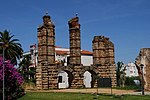Roman Theatre (Mérida)

The Roman Theatre of Mérida is a construction promoted by the consul Vipsanius Agrippa in the Roman city of Emerita Augusta, capital of Lusitania (current Mérida, Spain). It was constructed in the years 16 to 15 BCE. One of the most famous and visited landmarks in Spain, the Roman Theatre of Mérida is regarded as a Spanish cultural icon and was chosen as one of the 12 Treasures of Spain. The theatre has undergone several renovations, notably at the end of the 1st century or early 2nd century CE (possibly during the reign of Emperor Trajan), when the current facade of the scaenae frons was erected, and another in the time of Constantine I (between 330 and 340), which introduced new decorative-architectural elements and a walkway around the monument. Following the theatre's abandonment in Late Antiquity, it was slowly covered with earth, with only the upper tiers of seats (summa cavea) remaining visible. In local folklore the site was referred to as "The Seven Chairs", where, according to tradition, several Moorish kings sat to decide the fate of the city. It was built as part of an entertainment complex together with the Amphitheatre of Mérida. Nowadays both are part of the Archaeological Ensemble of Mérida, which is one of the largest and most extensive archaeological sites in Spain. It was declared a World Heritage Site by UNESCO in 1993.
Excerpt from the Wikipedia article Roman Theatre (Mérida) (License: CC BY-SA 3.0, Authors, Images).Roman Theatre (Mérida)
Calle José Ramón Mélida, Merida San Antonio
Geographical coordinates (GPS) Address Nearby Places Show on map
Geographical coordinates (GPS)
| Latitude | Longitude |
|---|---|
| N 38.915388888889 ° | E -6.3385 ° |
Address
Conjunto Arqueológico de Mérida
Calle José Ramón Mélida
06800 Merida, San Antonio
Extremadura, Spain
Open on Google Maps











